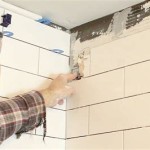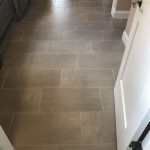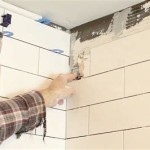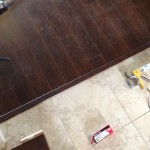Can You Fit Lino On Top Of Tiles? A Comprehensive Guide
The prospect of installing new flooring is often accompanied by considerations of cost, time, and effort. One common question that arises during home renovation planning is whether new flooring, specifically linoleum (lino), can be installed directly over existing tile. The answer is not a simple yes or no, as several factors influence the feasibility and success of such a project. This article will explore the various aspects of installing linoleum over tiles, providing a comprehensive understanding of the process and potential challenges.
Linoleum, often referred to as lino, is a resilient flooring material composed of natural ingredients such as linseed oil, rosin, cork dust, wood flour, and mineral fillers. These materials are combined and pressed onto a burlap or canvas backing. This composition provides durability, flexibility, and a degree of water resistance, making it a popular choice for kitchens, bathrooms, and other high-traffic areas. Its relative thinness also contributes to its appeal, particularly when considering installation over existing flooring.
The decision to install linoleum directly over tile hinges on several preconditions. Improper preparation or disregard for these factors can lead to a substandard result, characterized by uneven surfaces, premature wear, and even damage to the linoleum itself. Therefore, a thorough assessment of the existing tile floor and careful consideration of the installation process are paramount.
Assessing the Existing Tile Floor
The primary consideration before installing linoleum over tile is the condition of the existing tile surface. Any imperfections in the tile floor will inevitably telegraph through the linoleum, resulting in an uneven and potentially unsightly finish. A meticulous inspection of the tiles is necessary to identify any issues that must be addressed prior to installation.
One of the most critical factors is the levelness of the tile floor. While linoleum is somewhat flexible, it is not capable of compensating for significant variations in height between tiles. A floor that is severely uneven will result in a visibly uneven linoleum surface. To assess levelness, a long straightedge and a spirit level are essential tools. By placing the straightedge across different areas of the floor and using the spirit level to check for deviations, any high or low spots can be identified and marked. Small variations may be tolerable, but large discrepancies necessitate corrective action.
Another crucial aspect is the presence of any cracked, chipped, or loose tiles. These issues must be resolved before proceeding. Cracked tiles can create pressure points that will eventually cause the linoleum to split or tear. Chipped tiles introduce unevenness and potential sharp edges that can damage the linoleum. Loose tiles, if not properly secured, will move and shift under the linoleum, leading to instability and potential cracking. All damaged or loose tiles must be replaced or repaired using appropriate bonding agents and grout.
The grout lines between the tiles also present a potential challenge. Even if the tiles themselves are perfectly level, the grout lines can create subtle but noticeable indentations in the linoleum over time. This is especially true if the grout lines are wide or deep. To mitigate this issue, it is often necessary to fill the grout lines with a leveling compound to create a smooth, uniform surface. The choice of leveling compound is important; it should be compatible with both the tile and the linoleum adhesive. The leveling compound should be applied carefully, following the manufacturer's instructions, and allowed to dry completely before proceeding with the linoleum installation.
Finally, the cleanliness of the tile surface is paramount. Any dirt, grease, or debris will interfere with the adhesion of the linoleum. The tiles must be thoroughly cleaned and degreased using a suitable cleaning solution. After cleaning, the floor should be rinsed thoroughly and allowed to dry completely before applying any adhesive.
Preparing the Tile Surface for Linoleum Installation
Once the existing tile floor has been assessed, the next step is to prepare the surface for linoleum installation. This involves addressing any issues identified during the assessment and creating a suitable substrate for the linoleum to adhere to. Proper preparation is crucial for ensuring a long-lasting and aesthetically pleasing result.
As mentioned previously, filling the grout lines is often a necessary step. A self-leveling compound is typically used for this purpose. Before applying the leveling compound, it is important to prime the tile surface. Priming helps to improve the adhesion of the leveling compound and prevents it from drying out too quickly. A suitable primer should be selected based on the type of tile and the leveling compound being used. The primer should be applied evenly and allowed to dry completely before proceeding.
Once the primer is dry, the leveling compound can be applied. The leveling compound should be mixed according to the manufacturer's instructions to achieve the correct consistency. It should then be poured onto the tile floor and spread evenly using a trowel or squeegee. It is important to work quickly and efficiently to ensure that the leveling compound remains fluid and self-leveling. The thickness of the leveling compound should be sufficient to completely fill the grout lines and create a smooth, uniform surface. Once the leveling compound has been applied, it should be allowed to dry completely, which may take several hours or even days depending on the product and the ambient temperature and humidity.
After the leveling compound has dried, it may be necessary to sand the surface to remove any imperfections or ridges. This can be done using a fine-grit sandpaper and a sanding block or orbital sander. The goal is to create a perfectly smooth and even surface for the linoleum to adhere to. After sanding, the floor should be thoroughly cleaned to remove any dust or debris.
In some cases, an underlayment may be recommended in addition to filling the grout lines. An underlayment provides an extra layer of cushioning and helps to further smooth out any imperfections in the tile floor. It can also improve the sound insulation properties of the floor. When selecting an underlayment, it is important to choose one that is compatible with both the tile and the linoleum. The underlayment should be installed according to the manufacturer's instructions, typically using staples or adhesive.
Considerations for Linoleum Installation
With the tile surface properly prepared, the final step is the installation of the linoleum itself. This process requires careful attention to detail and the use of appropriate tools and materials. The success of the installation depends on the correct adhesive, proper cutting and fitting, and meticulous adherence to the manufacturer's instructions.
The choice of adhesive is crucial for ensuring a strong and durable bond between the linoleum and the prepared tile surface. A high-quality linoleum adhesive should be selected based on the type of linoleum being used and the specific application. It is important to read the manufacturer's instructions carefully and choose an adhesive that is recommended for use over non-porous surfaces such as tile. The adhesive should be applied evenly to the prepared surface using a notched trowel. The size and shape of the notches on the trowel will determine the amount of adhesive that is applied, so it is important to use the recommended trowel for the specific adhesive being used.
Before applying the adhesive, the linoleum should be cut to size and fitted to the room. This is a critical step that requires precise measurements and careful cutting. It is important to leave a small gap around the perimeter of the room to allow for expansion and contraction. The linoleum can be cut using a utility knife or a specialized linoleum cutter. It is important to use a sharp blade and to cut carefully to avoid damaging the linoleum.
Once the linoleum has been cut to size and fitted, it can be adhered to the prepared surface. The adhesive should be applied in sections, working from one side of the room to the other. After applying the adhesive, the linoleum should be carefully placed onto the adhesive and pressed firmly into place. A floor roller can be used to ensure that the linoleum is fully bonded to the adhesive and to remove any air bubbles. It is important to work quickly and efficiently to prevent the adhesive from drying out before the linoleum is in place.
After the linoleum has been installed, it should be allowed to cure for the recommended amount of time. This will allow the adhesive to fully bond and will ensure that the linoleum is securely in place. During the curing period, it is important to avoid walking on the linoleum or placing any heavy objects on it. Once the curing period is complete, the linoleum can be cleaned and sealed according to the manufacturer's instructions. A sealant will help to protect the linoleum from stains and scratches and will extend its lifespan.
In summary, installing linoleum over tile is possible, but it requires careful preparation and attention to detail. The condition of the existing tile floor must be thoroughly assessed and any issues must be addressed before proceeding. The tile surface must be properly prepared by filling the grout lines and, if necessary, installing an underlayment. The linoleum must be carefully cut and fitted, and a high-quality adhesive must be used to ensure a strong and durable bond. By following these guidelines, it is possible to achieve a beautiful and long-lasting linoleum floor over existing tiles.

Installing Luxury Vinyl Over Existing Tiles Choices Flooring New Zealand

How To Tile Over Linoleum Floors Correctly

Transform Your Home Installing Vinyl Flooring Over Ceramic Tiles City Wall And Floor

How To Install Vinyl Flooring Over Tiles Linoleum Thrift Diving

Can You Put Vinyl Flooring Over Tile Igloo Surfaces

Can You Lay Tile Over Linoleum Rubi Blog Usa

Can You Lay Vinyl Over Tiles Luxury Flooring Floorbay

How To Lay Vinyl Flooring Sheet Over Tiles

Should You Tile Over Vinyl Flooring Builddirect

Can You Lay Vinyl Flooring Over Tile Mersey
Related Posts








